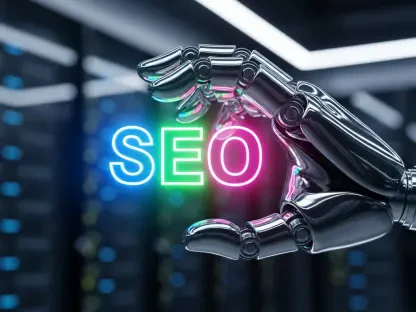In the rapidly evolving digital landscape of 2025, businesses face an unprecedented challenge in maintaining online visibility as search behaviors shift dramatically, with millions of users now turning to AI-driven tools like ChatGPT and Perplexity for instant answers alongside traditional search engines like Google. The battle for attention has never been more complex, and this comparison delves into two critical strategies—Traditional SEO (Search Engine Optimization) and AI Optimization, often referred to as Large Language Model Optimization (LLMO)—to uncover how they shape online presence. Both approaches aim to enhance visibility, yet they operate on fundamentally different principles, catering to distinct platforms and user expectations. The following analysis explores their unique mechanisms and offers clarity on navigating this dual landscape.
Introduction to SEO and AI Optimization
Traditional SEO has long been the cornerstone of digital marketing, focusing on optimizing web content to rank higher on search engine results pages (SERPs) like those of Google. This method relies on aligning with numerous ranking factors, such as keywords, backlinks, and site structure, to drive organic traffic. Its primary goal is to ensure that entire web pages appear prominently when users search for relevant terms, thus funneling visitors directly to a site.
In contrast, AI Optimization or LLMO targets the growing ecosystem of AI-driven search tools, which generate human-like responses by synthesizing information from across the web. Unlike SEO’s page-level focus, LLMO hones in on specific passages or content chunks that AI systems might cite in their answers, prioritizing relevance and depth over broad page authority. This approach caters to platforms where users seek immediate, conversational responses without necessarily visiting a website.
The relevance of both strategies cannot be overstated in today’s digital environment. While SEO remains essential for sustained organic growth and direct traffic, LLMO has emerged as a vital component with the rise of AI search usage, offering opportunities for brand mentions and authority in new search contexts. Although they share the overarching goal of enhancing visibility, their divergent methods and target platforms necessitate a detailed comparison to understand their respective strengths and applications.
Key Differences in Approach and Execution
Focus of Optimization: Page vs. Passage
Traditional SEO operates at the page level, aiming to optimize entire web pages to secure top positions on SERPs. This holistic approach involves refining titles, meta descriptions, and overall content to appeal to search engine algorithms, ensuring that a page comprehensively addresses a topic or query. For instance, a page about “best project management tools” would be crafted to rank for broad keywords and attract clicks through structured, authoritative content.
AI Optimization, however, shifts the focus to smaller, targeted segments of content, often individual paragraphs or sections. LLMO seeks to have specific passages cited directly in AI-generated responses, meaning that a single, well-articulated answer within an article could be pulled by tools like ChatGPT to address a user’s query. This granular approach requires content creators to prioritize clarity and relevance in discrete chunks, rather than the entire page’s performance.
This distinction highlights a fundamental difference in execution. While SEO builds a cohesive narrative across a page to influence rankings, LLMO concentrates on creating quotable, standalone insights that AI systems can easily extract and present. Understanding this split is crucial for strategizing content creation in a dual-search environment.
Content Strategy: Keywords vs. Intent
The content strategy for Traditional SEO heavily emphasizes keyword-driven material, targeting specific terms that users are likely to search. This often involves optimizing for high-volume, shorter phrases like “email marketing software” to capture broad audiences. Tools and analytics are used to identify popular keywords, ensuring content aligns with search engine expectations for relevance and authority.
Conversely, AI Optimization prioritizes user intent and conversational, long-tail queries that mirror natural language patterns. Instead of focusing on a generic term, LLMO targets detailed questions such as “What is the best email marketing software for a small business with a budget of $100 per month?” This reflects how users interact with AI tools, seeking nuanced, context-specific answers in a dialogue format.
This contrast in strategy underscores a shift in content creation priorities. SEO often builds around a central keyword theme to drive traffic, whereas LLMO crafts in-depth responses to specific scenarios, aiming for direct citation in AI answers. Adapting to both requires a balance of broad appeal and precise, intent-driven content that addresses varied user needs across platforms.
Success Metrics: Traffic vs. Mentions
Success in Traditional SEO is predominantly measured through metrics like organic traffic, impressions, and click-through rates. These indicators reflect how effectively a page draws visitors from search engines, with tools providing detailed insights into user behavior and engagement. High rankings translate to more clicks, making traffic a key benchmark for SEO performance.
AI Optimization, on the other hand, evaluates success through brand mentions, citations, and sentiment in AI-generated responses. Rather than focusing on direct site visits, LLMO tracks how often content is referenced by AI tools and the context in which it appears. This shift necessitates new measurement approaches, as visibility in AI answers does not always correlate with website traffic.
Tools like Semrush Enterprise AIO bridge this gap by offering insights into both traditional and AI metrics. They enable businesses to monitor SERP performance while also tracking AI visibility, such as mentions across platforms like Perplexity and Claude. This dual tracking is essential for understanding impact in a landscape where success is no longer solely about clicks but also about influence in AI conversations.
Challenges and Limitations of Each Approach
Traditional SEO faces several well-documented challenges, including the unpredictability of search engine algorithm updates that can disrupt rankings overnight. The intense competition for top spots often requires significant investment in content and backlink strategies, while building domain authority remains a slow, time-intensive process. These hurdles demand constant vigilance and adaptation to maintain visibility.
AI Optimization encounters its own set of difficulties, particularly the unpredictability of AI citation patterns. Unlike SEO’s relatively transparent ranking factors, determining why certain content is cited by AI tools can be opaque, making optimization a trial-and-error process. Additionally, tracking direct traffic from AI responses is challenging, as users often receive answers without visiting the source site, complicating ROI measurement.
Both approaches share concerns around content quality and trustworthiness, often encapsulated in the E-E-A-T framework (Experience, Expertise, Authoritativeness, Trustworthiness). However, LLMO places a heavier emphasis on balanced, thorough answers over promotional material, as AI systems favor neutrality. Technical barriers also persist, with SEO focusing on site speed and structure, while LLMO requires ensuring accessibility for AI crawling and addressing issues like JavaScript rendering that can obscure content from AI systems. Navigating these shared and unique obstacles is critical for effective implementation of either strategy.
Conclusion: Choosing the Right Strategy for Your Goals
Reflecting on the core distinctions, it becomes evident that Traditional SEO excels in driving direct traffic and establishing long-term visibility through search engines. Its strength lies in creating a robust foundation for organic growth, a proven method that businesses rely on for sustained audience engagement. On the other hand, AI Optimization carves out a niche with its potential for immediate citations and enhanced brand authority on emerging AI search platforms, offering a forward-looking edge.
For those who prioritize steady, measurable growth in website visits, sticking with SEO proves to be the safer bet during this period. However, for entities eager to capitalize on AI search trends, integrating LLMO provides a competitive advantage in capturing early visibility. A hybrid approach often emerges as the most practical solution, blending SEO’s established tactics with LLMO’s innovative content strategies to cover all bases.
Moving forward, businesses are encouraged to leverage tools like Semrush Enterprise AIO to monitor performance across both domains, ensuring adaptability as AI search evolves. The actionable step is to audit existing content for AI readiness, focusing on conversational depth while maintaining SEO fundamentals. By experimenting with both strategies and iterating based on data, companies can position themselves to thrive in an increasingly complex digital search environment.









